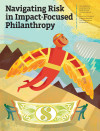 (Illustration by Jean Tuttle)
(Illustration by Jean Tuttle)
Trust is the United States’ most valuable asset. It provides the societal glue on which our democracy and our well-being rely. Without it, we cannot manage the dangers we face, nor steward the resources we share. Without it, we cannot solve large problems together.
Navigating Risk in Impact-Focused Philanthropy

This special supplement examines the concept of risk in philanthropy, providing insights, examples, and practical steps to help philanthropists better account for and manage risk as an integral part of the grantmaking process.
However, a large percentage of the public reports that they do not trust our government, and, perhaps more worrisome, that they often doubt the good intentions of others in our society. This mistrust reflects a longer-term trend, driven in large part by the information revolution and the accompanying bursts of digital media that favor the scandalous over the significant. But the trust deficit need not become a permanent feature of our democracy.
To rebuild trust, we will need to leverage our unique form of self-governance, in which the public, private, and philanthropic sectors each have a complementary role. Leaders from all three sectors can join forces to strengthen social capital, advance societal cohesion, and model collaborative problem-solving behaviors across sectors, disciplines, and even ideologies. Ideally, the solutions they identify, either individually or in combination, will reflect the best qualities that each sector brings to the table: the transparency and accountability of democratic governments, the efficiency and scale of the private sector, the agility and responsiveness of nonprofit organizations, and the risk appetite and long view of philanthropies.
The goal is so weighty and the task so urgent that each sector must be at the top of its game in order for their combined efforts to succeed. But is our sector—philanthropy—primed to deliver? Unfortunately, the current answer to that question may be “No.”
Is Philanthropy Too Wary?
Consider: The sector’s advantages are clear. Free from the exigencies of quarterly reports and the press of a 24-hour news cycle, foundations are unique in their capacity to absorb risk and maintain a long view. The nonprofits they support are purpose-driven, nimble, and close to the customers who are the beneficiaries of their work. At a time of dwindling trust, these civil society organizations are widely accepted as legitimate vehicles for citizens to share knowledge and engage in collective action.
Its relevance is established. Most Americans have been touched positively by a charitable institution—whether it be a nonprofit hospital, a community center, a place of worship and solace, the American Society for the Prevention of Cruelty to Animals, the local PTA, or the American Civil Liberties Union. Most have received a service from, given to, volunteered for, or know someone who works for a nonprofit. These are organizations that are trusted and relied upon in our daily lives.
Its intentions are known. In performing these philanthropic services, many in the social sector have worked to set and adhere to standards of transparency that go well beyond those required by law. Charitable organizations, foundations, and nonprofits alike actively share what they do, what they spend, and what they learn, for among their goals is the advancement of field-wide learning. In addition to sharing evidence of success or failure in their publications, they make public information about the business of philanthropy in their tax returns, their annual reports, and their various governance documents. Transparency and therefore trust between citizen and nonprofit, government and foundation, is a hallmark of philanthropy’s role in society. That openness contributes to their legitimacy.
But here’s the thing. Despite their shared commitment to transparency and learning with the wider public, grantors and grantees are often wary of one another, and that wariness can stand in the way of conversations about the level of risk each is willing to assume. Grant-seekers are loath to dwell on the difference between a “sound bet” and a “sure thing” for fear of scaring away a cautious donor. And grantmakers, intent on results, sometimes leave little to the discretion of a new grantee.
In short, when it comes to acknowledging, embracing, and managing risk, the charitable sector may lack the kind of trust for each other that it advocates for in society as a whole.
Do as I Say, Not as I Do
That was the supposition put forth by The Commons, a multistakeholder effort that brought together more than 20 leaders from the philanthropic sector to better understand risk in giving, and better understand what stands in the way of trust and transparency between foundations and nonprofits.
In my experience, grantmakers and grantees continuously confront a trust divide, with some very understandable reasons. After all, one seeks the resources that the other controls. The playing field is never level, and that fact inevitably introduces tension that can discourage frank admissions about the level of risk each is willing to take on. Therefore, the two sides rarely have a candid conversation about methods for risk management.
This mistrust results in abbreviated conversations between grantors and grantees that focus solely on the positive aspects of whatever engagement is on the table, rather than on the possible risks involved. Donors don’t ask, and grantees don’t tell. But the fallout of not discussing the risks inherent in a project is the greater level of mistrust that is created when something unexpected and negative happens during implementation (as it often does). Funders feel blindsided when a project hits a barrier or derails; nonprofits may end up abandoned by their partner at a time when they need support the most. There is plenty of room in such circumstances for either side to perceive itself as being mistreated.
My goal in joining The Commons was to home in on what it would take for more philanthropies to extend and receive greater trust from their nonprofit partners, and, depending on their risk tolerance, to gamble on a high-risk project that may offer a higher return. How smart is the risk culture? How smart can it be? How capable are donors and grantees at risk management? How can we improve that capability?
To begin answering these and other questions, we first turned to a survey conducted by Open Road Alliance in 2015 that revealed that grantmakers rarely ask grant applicants what could go wrong with their projects over the life of the grant. Their grant negotiations focus instead on how a prescribed logic model might drive certain results, rather than on the possibility of unexpected hazards along the way—dangers that could derail the project altogether. In fact, while foundations surveyed for the study reported that 20 percent of projects are compromised or even derailed by an unanticipated occurrence, only 17 percent of foundations surveyed set aside funds for such contingencies. As a result, the grantees could be starved of flexible resources at the very time they are most needed.
As noted in the resulting report, “All members of The Commons agreed that one of the most fundamental aspects of risk management lies within the funder-grantee relationship itself. Research shows that one of the primary barriers to successful risk management is a lack of transparency and trust between funders and nonprofits. … While managing risk is a shared responsibility, funders are in a unique position to implement practices that foster an environment that allows nonprofits to be more transparent about possible risks to impact and more trusting of funders as partners for impact.”
Ultimately, we developed five specific recommendations1 for funders. We believe that by following these recommendations, funders will build levels of trust with their grantees in short order. With higher levels of trust comes better tolerance for risk and management of risk. More risk tolerance and better risk management will lead to innovations that can make a lasting dent in solving our social challenges.
Here are the five recommendations:
- Lead by example—develop and share a “risk profile statement” to guide program officers and potential grantees alike.
- Start the conversation—include a conversation about risk in requests for proposals and grant application forms, signaling an understanding that risk resides in everything, and formally creating an opportunity to explore and reveal one another’s risk appetite.
- Be accessible—provide emergency contact information to all grantees. This way, if they need to check in when an unforeseen opportunity or barrier arises, they can do so swiftly. By providing this communication channel, funders signal their expectations that not all things can be predicted.
- Encourage program officers to develop empathy for nonprofit managers by encouraging them to serve on nonprofit boards. Move away from the tradition of hiring academics as program officers; opt instead for those with nonprofit experience of their own.
- Build nonprofit resiliency, by making capacity-building a goal and by explicitly supporting that goal.
This is a delicate moment in history; if our faith in existing institutions continues to decline rapidly, our capacity as a society will be reduced commensurately. The challenge of building social capital is a hard one, requiring an all-hands-on-deck approach. The charitable sector is an essential contributor, for it has maintained the popular trust. With this toolbox in hand, grantmakers can do even more to help their grantees realize their full potential, and to ensure that we deliver what we promise, truly to the best of our abilities.
There is much to gain, and it is well worth the risk.
Support SSIR’s coverage of cross-sector solutions to global challenges.
Help us further the reach of innovative ideas. Donate today.
Read more stories by Jane Wales.

